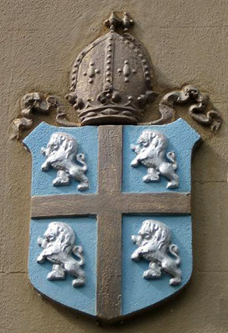
Life of Dr Handley Carr Glyn Moule DD (1841-1920)
Bishop of Durham

Compiled by Michael Russell OPC
for Fordington ©2007
last updated May 2013
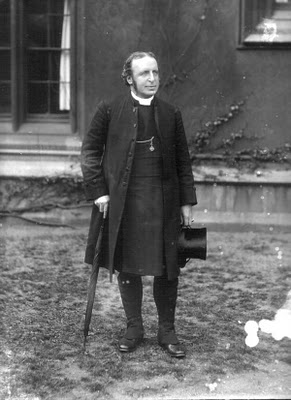
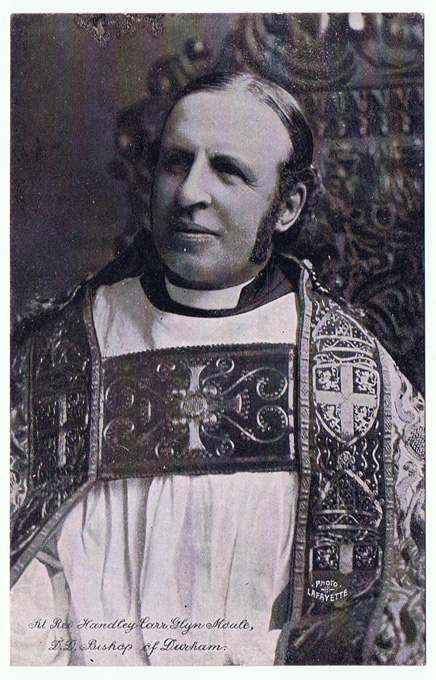
Handley Carr Glyn Moule was the youngest of eight sons of Rev. Henry Moule (1801 - 1880) by Mary Mullett Evans (1801-1877) and was born in Fordington on the 23rd December 1841. His father a prominent evangelical clergyman and Vicar of St George’s church carried out his baptism on 13th February 1842. Handley was named after his godfather Augustus Bernard Handley, a great friend of his father’s and Captain in the Army, who had been born in Bombay around 1803 but baptised back in England in Rochester Cathedral in 1810. Augustus had been ordained under his fathers ministry and was living in Fordington as early as 1835 carrying out many baptisms etc in St Georges Church in the 1840's. At his fathers request Augustus was appointed as the first incumbent of Christ Church, the small Chapel his father built for the soldiers housed in the Barracks at West Fordington a position Augustus held until 1859. Handley's second and third names came from the Rev Carr John Glyn the Rector of Witchampton(6), another wealthy friend, also his godfather, who was a champion of the poor, the staunchest of protestants and a loving devotee of the Bible Society who survived until 1896 only 20 months short of his century.
Handley was born into a busy household. His mother Mary, a well educated and devout Christian, loved her children dearly and made sure she spent time with each, so that none felt deprived of affection. Particularly in the early years she constantly played and read to them stories of the day such as “Uncle Toms Cabin”. It was her role to teach them the basics of reading, writing and arithmetic before formally handing them over to their father who apart from some of his elder brothers he taught alongside six to eight paying pupils who came to him in preparation for University. The pupils would arrive in February and stay until midsummer to return in August until Christmas was at hand. With a constant stream of religious visitors, who came to seminars organised by his father some of whom stayed with them, it was not unusual to have 17 or 18 to cater for. With such a busy household to run Mary employed a Nurse (Susanna Northover from Cerne)(1) to look after the younger children. Handley described her as “the Truest of Dorset Women, our severe but devoted guardian; her whole heart given to us long after she had left their circle”. His early childhood was therefore spent at the Vicarage which is shown above sketched as it stood in 1864 by his own hand. Handley described the Vicarage in 1913 from which we can also glean a keen insight into his early childhood:- "It is a rather long and rather low building, standing just off the road which runs from the east through Fordington into Dorchester. From the lower levels of the village the road climbs to a gentle hilltop where for at least fifteen centuries the dead have been buried, and where the fine perpendicular tower of the parish church looks down upon the water-meadows of the Frome and the trembling blue line beyond the Purbeck Hills. The village green bordered with houses, lies close to the churchyard to the south. You walk on towards Dorchester for a few hundred yards, and on your left hand a pair of stone steps leads up from the road to the sidewalk, and door in a wall swings open, and you stand in the front garden of the house where I was born. Embedded in the wall of the house, close to the front door is the tracery of a medieval window, discovered some sixty years ago by my Father when he made certain changes in the structure; a sign that a priest's house must have stood there already in the early fifteenth century. You enter, and find a dwelling seemly, roomy, of entire simplicity. The dining room is spacious, as long as the depth of the house; otherwise the chambers are all of a modest scale. they look out, almost all, on the pleasant garden at the back, on lawn, paths, beds and embowering sycamores. The garden adjoins a field, once our field for cricket and other games, now used, I believe, as a public playground ---- The dear house itself - how shall I describe it? each room was an individual friend. There was my mother's 'Little Parlour' the scene of my infant lessons at her side, and of her lifelong activities of intercourse, correspondence, and a hundred works of love. My 'Father's study' was next to it, a sacred room, where grave things in the service of God and man, little understood by the child, were done day by day by the busy pen and studious eyes, but where also we children spent many a happy hour. I remember, very early in my life, times spent there late on the Sunday afternoon, when the dear Father talked to me about Christian History, or showed me the mysterious Greek letters. Then there was the Great Room. In any other house it would be the dining room; but to us it was always 'The Study' because in the days of the pupils it was used as the chief classroom, between the hours of meals. Out of it opened its counterpart, the 'Play Room' used also for lessons, but much more as the place reserved for all the odds and ends of time. Many a merry indoor game it witnessed, and I still hear the voices that joined in part-songs there on a winter evening, taught and led by my brother Horace, one of whose many gifts was music. Upstairs there were many rooms precious now to memory, and first, though remotest, let me name the 'Nursery'. I clearly remember lying there, a very small child (for I often ailed in early days, though mercifully healthy in my adult life) in the lap of my dear nurse, Susan Northover(1). There I see my kind elder brothers and their schoolfellows, amusing the weak child by dropping melted lead into water and exhibiting the freaks of shape which would result. Again a little later, my brothers Horace and Charles would come up to sit by the nursery fire and read the then recent 'Lays of Rome' to the wondering nurse and her little charges. I say charges, in the plural for a dear young orphan cousin, Matthew Evans(2), now a much respected Canterbury rector, was brought in 1846 to grow up with me; the scene is still vivid to my mind when the little boy was listed down at our door from the Bristol coach, while I looked on with a mixture of welcome - and jealousy. In the nursery-wall was a door, opening into 'the closet', a little dark chamber with many shelves, full of multitudinous toys - articles most of them, strong and durable, long lived friends of those dear days. The mystery and shadows of the closet were an attraction in themselves; the wooden horse, the windlass and water-bucket, the puzzle-boxes, the wooden spades, suggestive of the mystery and glory of Weymouth or Lulworth sands - all seemed something more than themselves within it. Then there was the great rocking horse on the nursery floor, an inexhaustible delight, whether the child was gallantly mounted on his back or balanced against another rider on the end of the rockers. Dear room! Its pictures, its bookshelf, its wardrobe; they are all part of my mental furniture still; and some of the pictures and many of the books are with me in my later home to-day; the wardrobe does its duty still at Auckland Castle"(3). Trinity College Cambridge 1860-1865 Curate at Fordington (1867-1873) & (1877-1880) In 1867 Handley was ordained as a deacon in the church and served at his fathers parish in Fordington as assistant curate. He served there from 1865 to 1873 taking over from his brother George Evans Moule. His ordination as a priest was at Ely in 1868 but throughout he maintained his association with his college. As an MA graduate he was eligible for the Seatonian Prize for the best English poem on a sacred subject, which he won for 4 years in a row (1869-1873) and again in 1876. In 1873 he was elected sub-dean of Trinity College which drew him away from Fordington until 1876 when he returned to resume his curacy. He maintained for some years his interest in classical studies: so much so that expert teachers of Latin and Greek verse compositions at Cambridge, as they read to their pupils some exquisite rendering of Handley’s which had become part of a coach’s stock-in-trade, would sigh over the thought that such a scholar should be wasted on theology. He remained curate at St George’s Church in Fordington from 1877 until his father’s death in 1880, when the vicarage which had been the family home for over 50 years went to the new incumbent. In 1880 he published a Commentary on the Epistle to the Romans and was select preacher at Cambridge in the years 1880, 1882, 1891, 1894, 1896, 1899, and 1900, as well as at Oxford in 1895. First Principal of Ridley Hall 1880-1899 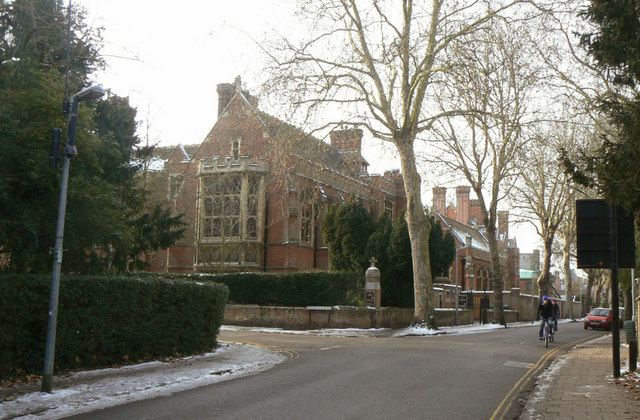 Ridley Hall Theological College Cambridge Picture © Alan Murray-Rust Licenced for re-use under Creative Commons Licence His position as a prominent Evangelical Minister was recognized in 1880 by his election as the first principal of Ridley Hall Theological College, Cambridge, an establishment founded for post-graduate training for the Ministry. It was named after Nicholas Ridley a leading protestant theologian and martyr who was executed at Oxford in 1555. Handley's influence in his position as principal was considerable, and he widened his influence by the production of various religious works of a popular kind, among them being Thoughts on Christian Sanctity (1886) and The Secret of the Presence (1901). Marriage to Harriet Mary ELLIOTT - 1881 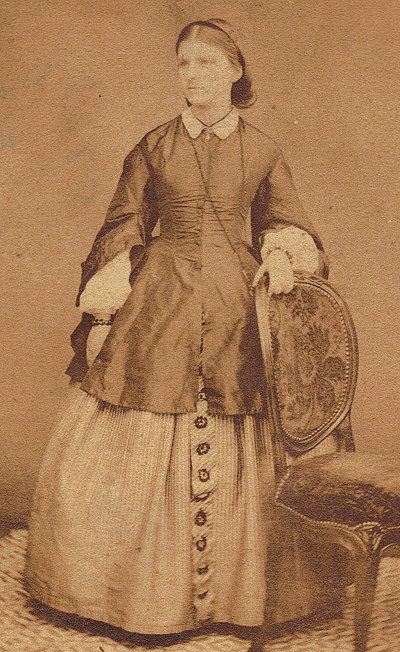
On the 16th August 1881 Handley married a 36 year old lady by the name of Harriet Mary Elliott. She had been born in Paris on 29th Sep 1844 and was known by her second name of Mary. She was the daughter of the late Rev Charles Boileau Elliott MA, FRS, FRGS JP (1803-1875) who died in Geneva on 1 July 1875 at the age of 72. Her father a graduate of Queens College Cambridge initially worked for the East India Company before taking orders and becoming the vicar of Godalming in Surrey in 1833. In 1838 he was appointed as the Rector of Tattingstone near Ipswich an important holding worth £500 a year with a house and 38 acres of glebe, which is where her elder sister Emily had been born in 1839. Mary had a rather unusual start to life as after her birth, because of her fathers travels, Mary was left with a French Doctor and his wife and a wet nurse for two years before rejoining the family when they returned to England in 1846. Just before her marriage to Handley Mary was living with her sister Emily and her husband the Rev John Barton who was Vicar of Holy Trinity Church in Cambridge. Her sister Emily left an extensive memoir which can be accessed via the link that I have provided, as can pictures and more background regarding their family. Handley and Mary were to raise two children. The first was Mary Emily Elliott MOULE (1882-1905) who was born on 17th Nov 1882 but known as Tesie (short for Tesorina meaning 'little treasure'). Unfortunately she was to die at the young age of 22 on 26th August 1905. A touching tribute to her was published by her father in 1907 and can be accessed via this link. Their second child was Isabel Catherine Moule (1884-1959) who married in 1906 Robert Steven de Vere and died in 1959 aged 75. Chaplain to Queen Victoria 1898-1901 In 1898 in recognition to his long and distinguished service, Handley was made Honorary Chaplain to Queen Victoria, and in 1901 Chaplain in ordinary to King Edward VII. The following year he published Outlines of Christian Doctrine. Also in 1899 he was elected to the Norrisian professorship of divinity at Cambridge and as a convinced evangelical minister he represented evangelicals at the Round Table Conference on Holy Communion in 1900. Bishop of Durham: 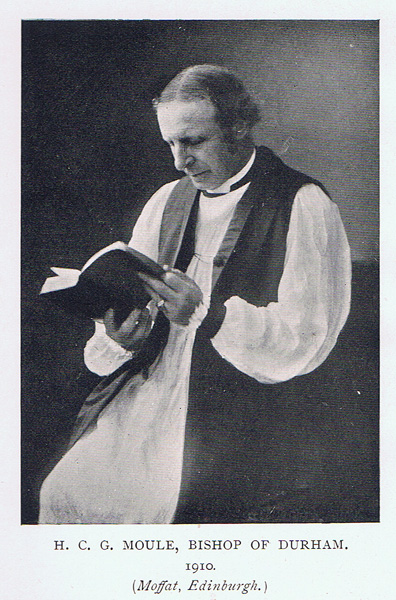
In 1901 he succeeded Brook Foss Westcott as Bishop of Durham, a position he
held until his death in 1920.
As such he assumed responsibility for the diocese of Durham one of the oldest in the country and its Bishop is a member of the House of Lords. Other duties include, along with the Bishop of Bath and Wells, escorting the sovereign at the coronation. The Times newspaper for Monday June 19th 1911 printed an article listing many of those that were due to take part in the service for the Coronation of George V and this includes a very rough sketch of Handley as the Bishop of Durham. Although George V became King on the death of King Edward VII on 6th May 1910 his Coronation did not take place until 11th June 1911. Whilst living at Auckland Castle in 1908 Handley chaired the missionary section of the Pan-Anglican Congress and was closely associated with the Keswick Convention. He was pre-deceased by his wife who died at the Castle on 14th July 1915. Handley died on the 8th May 1920(4) of pleurisy at the home of his brother Charles (Senior Fellow and President of Corpus Christie College) in Cambridge. Probate shows that he left an estate of £15,905. 11s 0d. Publications: Among his numerous works are: Apollo at Pherae (Cambridge, 1865); Poems from Subjects Connected with the Acts of the Apostles (London, 1869); Fordington Sermons (1882); Christianus, a Story of Antioch, and Other Poems (1883); Justifying Righteousness (1885); Thoughts on Union with Christ (1885); Thoughts on the Spiritual Life (1887); The Christian’s Victory over Sin (1887); The New Birth (1888); Outlines of Christian Doctrine (1889); Secret Prayer (1889); The Net and the Deliverance (1889); Veni Creator (1890); The Cup of the Covenant (1890); Daniel: or , the Secret of Continuance (1890); Life in Christ and for Christ (1890); The Oak of Ephrah (1891); At the Holy Communion (1892); Jesus and the Resurrection (1893); Charles Simion (1895); Grace and Godliness (1895); In the House of the Pilgrimage (1896); The Sacrament of Baptism (1896); Prayers and Promises (1896); Philippian Studies (1897); Colossian Studies (1898); Our Prayer-Book (1898); Confession (1899); On the Holy Communion (1899); Our Great High Priest, (1899); Ephesian Studies (1900); The Secret of the Presence, and other Sermons (1900), The Evangelical School in the Church of England (1901), From Sunday to Sunday (1903); Justification by Faith (1903); Temptation and Escape (1903); Imitations and Translations (1904); The School of Suffering (1905); My Brethren and Companions, and other Sermons (1905); Second Epistle to Timothy (1905); Holiness by Faith (1906); Scenes in the Life of our Lord (1907); The High Priestly Prayer: a devotional Commentary on the 17th Chapter of St. John (1907); Christ’s Witness to the Life to Come, and Other Sermons (1908); Faith, its Nature and Work (1909); and Messages from the Epistle to the Hebrews (1909). He likewise prepared for The Cambridge Bible the volumes on Romans (Cambridge, 1879), Ephesians (1886), Philippians (1889), and Colossians and Philemon (1893); for The Expositor’s Bible the volume on Romans (London 1894); and for the Cambridge Greek Testament the volume on Philippians (Cambridge, 1897). Note: Good quality photographs exist of Handley, two at the V&A images collection and one when he was aged about 55 in the Cambridge Antiquarian Society Portrait Collection Ref CAS F58 1896 Genealogical Notes:- |